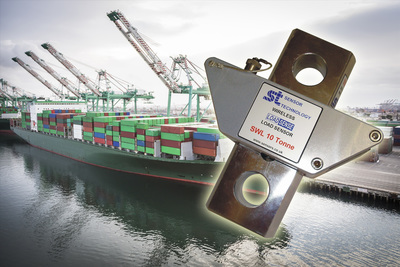
Contact Details:
EngNet - Engineering Network
11121 Carmel Commons Blvd.
Charlotte
NC
28226
United States of America
Tel: +01 704 5413311
Fax: +01 704 9430560
Send Enquiry | Company Information

Innovative wireless weighing technology could help shipping operators meet amended Solas requirement
Product News Monday, May 23, 2016: EngNet - Engineering Network
Not only can the new technology weigh containers in line the with the updated Solas requirements, but it also provides the long term data storage and analysis that operators need in order to ensure that lifting operations are being undertaken within specific parameters. It provides operators with the information they need to enable load limiting, optimise service life and calculate remaining safe working period.
On November 21 2014, the IMO’s Maritime Safety Committee officially adopted the new Solas requirement that, as a condition for vessel loading, the weight of a packed export container must be verified by the shipper. The intention is to reduce the number of accidents caused globally by containers whose weights have been erroneously declared.
Under the legislation, verification of the packed containers’ weight will be a condition for vessel loading. Two methods of verification have been deemed acceptable by the IMO: either weighing the loaded container or weighing the cargo and then adding the tare weight of the container.
There are said to be many within the industry who are still completely unaware of the pending legislation, and may be caught out by the July 2016 implementation date. Many more within the shipping community are worried about how the requirements will be executed, what the cost of implementation will be, and how the legislation will be enforced.
For operators within the port industry who do not have weighing equipment installed, the required investment cost could look frightening. But the new weight measurement technology could provide an effective and affordable solution.
Designed and manufactured by Banbury based Sensor Technology, LoadSense can be easily integrated within the crane hook. It allows weighing processes to be fully integrated with handling operations. All live data is captured in real time and can be transferred to a database, stored, totalised and analysed. An on-board single chip computer records, analyses and archives readings, while wireless communication capability can transfer data in real time to a host computer.
LoadSense employs internal batteries, which make its operation completely autonomous. As such it can be deployed with minimal disruption to mobile harbour crane operations, and will automatically begin transmitting data. No special training is required to install or operate the unit.
The LoadSense package includes the intelligent load sensor itself, plus a hand-held receiver display. The load sensor is based on proven strain gauge technology, and is calibrated, as standard in the range from 1 to 20 tonnes, with other ranges up to 50 tonnes available soon.
The transmitter (operating on an unrestricted 2.4 GHz waveband) enables accurate load data to be sent to a variety of displays simultaneous, a hand held display, a cabin mounted display, and a receiver connected to a PC. This allows real time measurement of the load at the same time as recording and processing real time values.
With over 20 years of research and development into digital torque monitoring, Sensor Technology is at the forefront of this technology and is an acknowledged leader in the manufacture of wireless load sensors. It has a global network of distributors assisting sales, and a network of world-renowned technical experts assisting in the development of technology.
LoadSense and its sister technology, TorqSense, are already being adopted within mobile harbour cranes around the world for dockside unloading operations. They are seen as important enabling technologies for improving safety, while also aiding asset availability by facilitating proactive rather than reactive maintenance. It combines a unique principle of operation with ease of integration and comprehensive data.
These same benefits could be a real boon to port operators in meeting the requirements of the amended Solas legislation. Easy to install, it could be a key enabler to meeting the July 2016 deadline.
